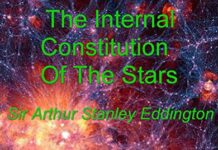
Ebook Info
- Published: 2015
- Number of pages: 368 pages
- Format: PDF
- File Size: 33.98 MB
- Authors: Sir Arthur Stanley Eddington
Description
This book, written in 1936, was Arthur Eddington’s first technical effort at a vision for harmonization of quantum physics and relativity, and was followed by ‘Fundamental Theory’, left uncompleted in 1944. ‘Protons and Electrons’ is a much more connected and internally integrated work, although it represents an earlier point in the author’s thought arc.The physical and mathematical reasoning are very deep, but it is possible to enjoy much of the flavor of the book even without following everything. The tidbits given below illustrate Eddington’s beautiful and mellifluous English style. One strand of opinion on RTPE is that he disguised the gaps in the argument with rhetoric, but the final verdict on many of his ideas is not yet in.WARNING: Due to the complexity of the mathematical typesetting, the only way to reproduce this book has been as a series of scanned page images. On a portable electronic reader they come out pretty small, but they are legible. The smaller your screen is, the smaller they will appear. On a proper desktop computer running the app, they are perfectly fine.TIDBITS:● We contemplate an earth-moon system, which is not merely a mental association of the earth and moon, but comprises physical relations between the two bodies not to be found in either body separately. The essence of the process of “combining” is the substitution of a single time coordinate for the whole system instead of independent time coordinates for its separate parts.● Owing to the curious fact that our minds are acquainted by sensory mechanism with the past but not the future, observational knowledge has the form of an integral over past time up to the present moment. Since probability is relative to knowledge, a formulation of the universe in terms of probability distributions is exceedingly unsymmetrical with respect to past and future time.● We thus discard the naive idea that in the beginning there was a cosmical constant; and that, when the universe was made, the Creator had to decide whether the amount of matter created should be greater than, less than, or equal to the standard mass fixed by it.● It cannot seriously be maintained that the Coulomb force, which prevents two slow moving electrons from approaching one another, is an altogether distinct phenomenon from the exclusion principle (contained in Fermi-Dirac statistics) which achieves the same result by forbidding them to occupy the same phase cell. ● There is nothing mystical about the effects of indistinguishability. We do not suppose that an electron knows that it will not be distinguished from other electrons, and on that account conducts itself differently. The dynamical equations depend, not on whether the particles are intrinsically distinguishable or indistinguishable, but on whether and to what extent they are in fact distinguished.● Theoretical physics is intended to agree with the experience of an observer who does not make mistakes, and will take varying forms according to the definition of what constitutes a mistake.● Consider a double star with equal components, having a very large orbital velocity in the line of sight. We can distinguish the two components by observing that one is red and the other blue. Half a period later we can again distinguish the red star and the blue star. But the stars thus identified do not obey the accepted laws of celestial mechanics.● The mind which tried to apprehend simultaneously the complexity of the universe would be overwhelmed. Experience must be dealt with in bits; then a system must be devised for re-connecting the bits; and so on. One outcome of this treatment is that the universe is passed through a sieve with 3.10^79 holes to render it more comprehensible.● We may look forward with undiminished enthusiasm to learning in the coming years what lies hidden in the atomic nucleus – even though we suspect that it is hidden there by ourselves.
User’s Reviews
Reviews from Amazon users which were colected at the time this book was published on the website:
⭐
Keywords
Free Download Relativity Theory of Protons and Electrons: Eddington Masterpieces #3 (Eddington Masterpieces (illustrated)) in PDF format
Relativity Theory of Protons and Electrons: Eddington Masterpieces #3 (Eddington Masterpieces (illustrated)) PDF Free Download
Download Relativity Theory of Protons and Electrons: Eddington Masterpieces #3 (Eddington Masterpieces (illustrated)) 2015 PDF Free
Relativity Theory of Protons and Electrons: Eddington Masterpieces #3 (Eddington Masterpieces (illustrated)) 2015 PDF Free Download
Download Relativity Theory of Protons and Electrons: Eddington Masterpieces #3 (Eddington Masterpieces (illustrated)) PDF
Free Download Ebook Relativity Theory of Protons and Electrons: Eddington Masterpieces #3 (Eddington Masterpieces (illustrated))
